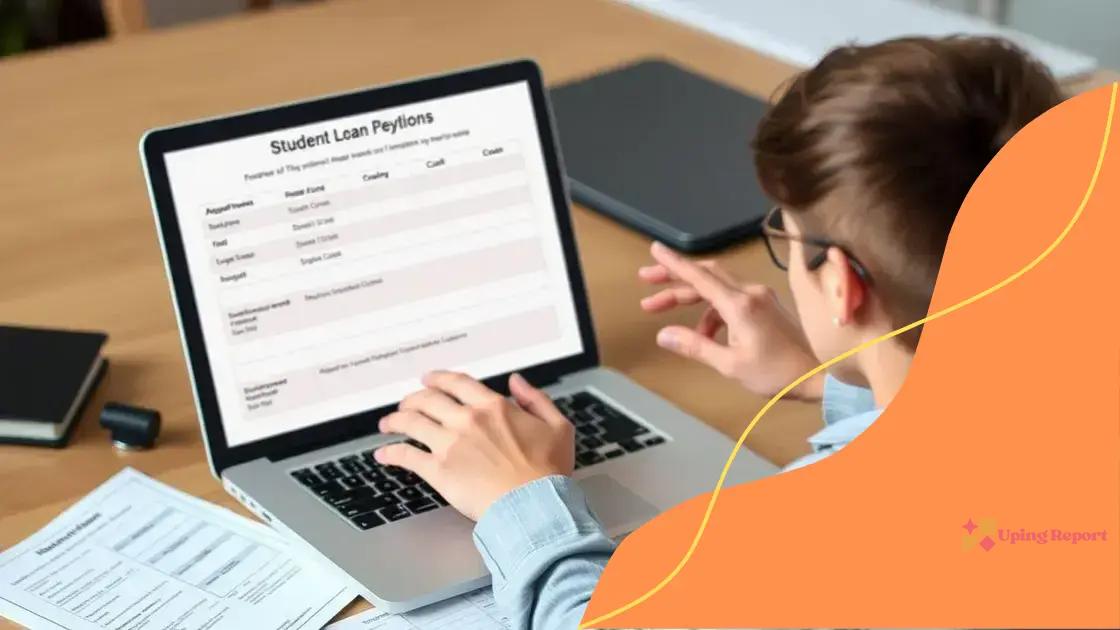Student loan repayment updated: what students should know

Student loan repayment requires understanding various plans, managing payments effectively, and utilizing forgiveness options to alleviate financial burdens after graduation.
Student loan repayment updated has become a hot topic, especially for recent graduates. With changes rolling out, many borrowers are wondering how they will impact their financial futures. Ready to dive into what’s new and what it means for you?
Understanding recent changes to student loan repayment
Understanding the recent changes to student loan repayment is crucial for borrowers. With the evolving landscape of student loans, these updates can impact your financial strategies significantly.
There have been several changes in regulations that affect repayment plans, eligibility for forgiveness, and the overall management of loans. Staying informed helps you make better decisions regarding your repayments.
Key Updates on Repayment Plans
Recent updates have introduced various repayment options designed to suit different financial situations. It’s essential to know your choices:
- Income-driven repayment plans can adjust monthly payments based on your income.
- Standard and graduated repayment plans offer structured payments over time.
- Extended repayment plans can stretch payments over a longer period, reducing monthly costs.
Another significant aspect to consider is the impact of loan forgiveness programs. Many borrowers are now eligible for forgiveness after making consistent payments for a specific period, which can greatly relieve financial stress.
As we delve deeper into loan repayment strategies, remember that understanding your rights and responsibilities as a borrower is vital. Take advantage of resources and support available to navigate these changes effectively.
Preparing for New Repayment Requirements
Preparing ahead for these new repayment requirements can lead to better financial health. Begin by reviewing your loan balance and types of loans you hold.
Stay engaged with updates from your loan servicer, as they can provide information about your repayment schedule and any upcoming changes. This knowledge can empower you to plan accordingly.
Incorporate budgeting into your financial strategy to account for student loan repayments. Having a solid financial plan that considers these payments can minimize surprises down the road.
Tips for managing your student loan payments
Managing your student loan payments can feel overwhelming, but with the right strategies, it can become manageable. Knowing how to handle your loans effectively is essential for your financial health.
Start by keeping track of your loans. Understanding how much you owe and who your loan servicer is makes the process easier. This information is foundational for managing payments.
Creating a Budget
A budget is your best friend when it comes to managing student loans. Allocate a specific amount for your loan payments each month. Make sure to include this in your overall budget plans.
- Identify all your monthly expenses.
- Set aside money for savings.
- Ensure your student loan payment fits into your budget.
Having a clear budget helps you avoid missed payments and late fees.
Considering Automatic Payments
Another helpful tip is to enroll in automatic payments. This ensures your payments are made on time, reducing stress and helping you avoid penalties. Some lenders even offer a discount on your interest rate if you set up automatic payments.
Moreover, staying in communication with your loan servicer can make a significant difference. If you face financial issues, reach out to them. There may be options available such as deferment or forbearance that can help you manage payments temporarily.
Finally, keep an eye on interest rates and any changes regarding your loans. Knowledge of these aspects can help you make informed decisions moving forward. By staying proactive, you can effectively manage your student loans without feeling overwhelmed.
Exploring different repayment plans available

When it comes to student loan repayment, it’s important to explore the various plans available. Each option has its features and benefits, allowing borrowers to find the right fit for their financial situations.
Understanding the different repayment plans can help you manage your student loans more effectively. Here are some common types:
Standard Repayment Plan
The Standard Repayment Plan requires fixed monthly payments for up to ten years. It offers the most straightforward approach but can be challenging if you have a large loan balance.
Income-Driven Repayment Plans
These plans adjust your monthly payments based on your income and family size. Options under this category include:
- Income-Based Repayment (IBR)
- Pay As You Earn (PAYE)
- Revised Pay As You Earn (REPAYE)
- Income-Contingent Repayment (ICR)
These plans can greatly reduce your monthly payments, making them more manageable, especially for those with fluctuating incomes or lower earnings.
Graduated Repayment Plan
The Graduated Repayment Plan starts with lower payments that increase every two years. This plan is great for those who expect their income to rise significantly in the future.
Extended Repayment Plan
If you have over $30,000 in federal student loans, you may qualify for the Extended Repayment Plan. This plan allows payments to be spread over 25 years, resulting in lower monthly payments.
Don’t forget that some repayment plans may lead to greater total interest costs over time. Therefore, weigh your options carefully before making a decision. It’s wise to calculate how much interest you’ll pay under each plan and how long it will take to pay off your loans.
Impact of forgiveness programs on loans
The impact of forgiveness programs on loans is a crucial topic for many borrowers. These programs can offer significant relief, especially for those struggling with high student loan debts.
Debt forgiveness programs are designed to forgive a portion of student loans after meeting certain criteria. Understanding how these programs work helps borrowers benefit from them effectively.
Types of Forgiveness Programs
There are several forgiveness programs available, each with unique requirements:
- Public Service Loan Forgiveness (PSLF): This program forgives loans after 120 qualifying monthly payments while working full-time in a qualifying public service job.
- Teacher Loan Forgiveness: Teachers in low-income schools may qualify for forgiveness of up to $17,500 after five years of teaching.
- Income-Driven Repayment (IDR) Forgiveness: Borrowers may have their remaining loan balance forgiven after 20 or 25 years of payments under an IDR plan.
Each program targets specific groups and requires careful attention to eligibility criteria. Borrowers must ensure they meet all stipulations to take advantage of forgiveness.
Participating in these programs can drastically change a borrower’s financial future. It’s essential to keep in mind the necessary documentation and track qualifying payments accurately. Failing to do so could jeopardize forgiveness opportunities.
The potential benefits of forgiveness programs are substantial. Many borrowers may find that after years of consistent payments, they can eliminate a sizable portion of their debt, allowing them to focus on other financial goals.
Preparing for student loan repayment: what to expect
Preparing for student loan repayment is a key step for anyone who has borrowed money for college. Knowing what to expect can make the process smoother and less stressful.
As your repayment period approaches, it’s essential to gather all necessary information regarding your loans. Review loan details such as the total amount borrowed, interest rates, and the types of repayment plans available. This information is critical for making informed decisions.
Understanding Your Grace Period
Most federal student loans offer a grace period before payments begin. This period usually lasts six months after graduation or dropping below half-time enrollment. During this time, you won’t have to make payments, but interest may continue to accrue.
Choosing a Repayment Plan
Before your first payment is due, take time to explore your repayment options. Different plans are designed to fit various financial situations. Some may allow for lower initial payments, while others may help you pay off the loan faster:
- Standard Plan: Fixed payments over ten years.
- Income-Driven Repayment: Payments based on your income and family size.
- Graduated Plan: Starts with lower payments that increase over time.
Make sure to choose the plan that aligns with your budget and financial goals.
Additionally, don’t hesitate to reach out to your loan servicer for assistance or clarification on terms. They can provide insights about payment structures, deferment options, or consolidation applications if necessary. Staying informed about the terms can help maintain a better repayment experience.
Finally, create a budget that includes your expected monthly loan payments. This will help you manage your finances effectively and ensure you do not miss payments when they begin.
In summary, understanding student loan repayment is essential for anyone with loans. By exploring different repayment plans, staying informed about forgiveness options, and preparing properly, you can navigate this process more easily. Remember to budget effectively and communicate with your loan servicer whenever needed. With the right strategies, you can manage your loans and work towards a brighter financial future.
FAQ – Frequently Asked Questions about Student Loan Repayment
What is a grace period?
A grace period is the time after graduation when you are not required to make loan payments, usually lasting six months.
How do I choose the right repayment plan?
Consider your financial situation, monthly budget, and long-term goals when selecting a plan that suits your needs.
What options are available for student loan forgiveness?
Options include Public Service Loan Forgiveness, Teacher Loan Forgiveness, and Income-Driven Repayment forgiveness plans.
How can I stay organized with my student loans?
Keep track of your loans, payment schedules, and any communication with your loan servicer to ensure timely payments and good financial health.
